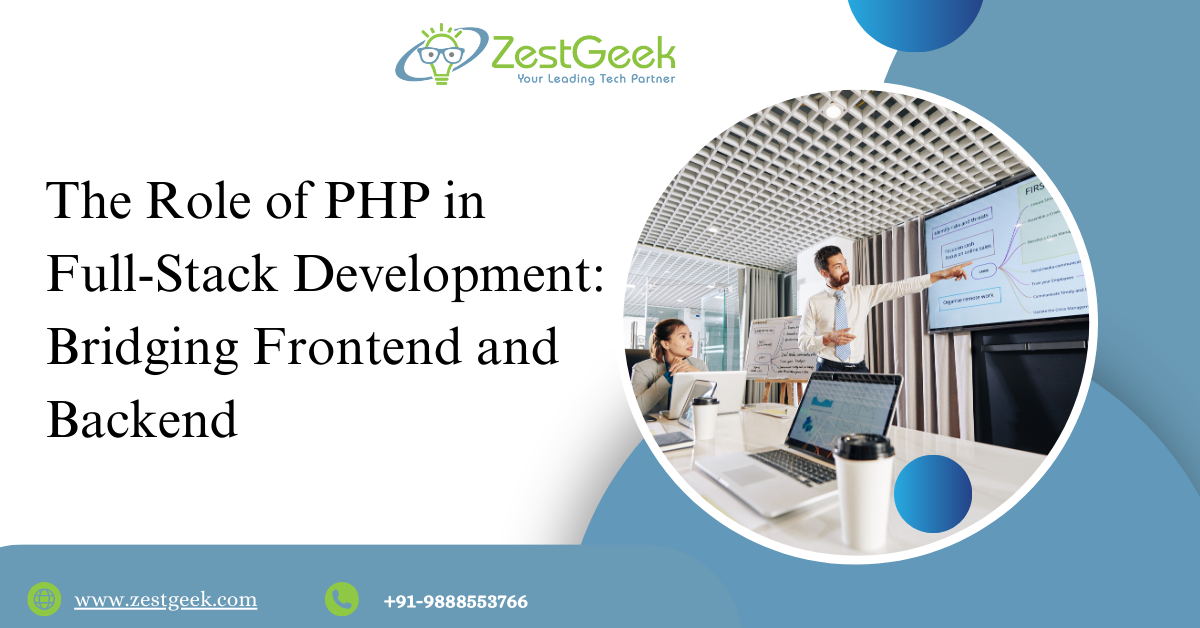The Role of PHP in Full-Stack Development: Bridging Frontend and Backend
 Zestgeek
Zestgeek
In the dynamic world of web development, full-stack developers are the versatile maestros who orchestrate both the frontend and backend components of web applications. While various technologies and languages vie for prominence in this domain, PHP, bolstered by comprehensive PHP development services, continues to play a pivotal role in full-stack development. This article delves into how PHP bridges the gap between frontend and backend, offering a comprehensive solution for modern web development.
The Enduring Popularity of PHP
PHP (Hypertext Preprocessor) has been a staple in web development since its inception in 1994. It powers a significant portion of the web, including major platforms like Facebook and WordPress. Its enduring popularity can be attributed to several factors:
1.Simplicity and Ease of Use: PHP’s syntax is straightforward, making it accessible for beginners while still powerful enough for seasoned developers.
2.Vast Ecosystem: PHP boasts a rich ecosystem of frameworks (such as Laravel and Symfony), content management systems (like WordPress and Drupal), and a plethora of libraries and tools.
3. Flexibility: PHP seamlessly integrates with various databases and frontend technologies, providing a flexible environment for full-stack development.
PHP in the Backend
PHP’s primary role has traditionally been in backend development, where it excels in creating dynamic and data-driven websites. Here’s how PHP contributes to backend development:
1. Server-Side Scripting: PHP is executed on the server, generating HTML content that is sent to the client’s browser. This server-side processing is crucial for creating dynamic web pages that interact with databases and other server-side resources.
2. Database Interactions: PHP provides robust support for interacting with databases like MySQL, PostgreSQL, and SQLite. With extensions like PDO (PHP Data Objects), developers can execute SQL queries securely and efficiently.
3. Security Features: PHP includes built-in features to handle security concerns, such as input validation, output escaping, and protection against common vulnerabilities like SQL injection and cross-site scripting (XSS).
PHP Bridging the Frontend
While PHP is a backend powerhouse, its role in full-stack development involves significant interaction with front-end technologies. Here’s how PHP bridges the gap:
1. Template Engines: PHP-based template engines like Blade (used in Laravel) and Twig (used in Symfony) facilitate the seamless integration of backend logic with frontend presentation. These engines allow developers to write clean, reusable, and maintainable HTML templates.
2. AJAX and APIs: PHP can handle asynchronous requests (AJAX) to create dynamic, responsive user experiences. It also excels at building RESTful APIs, enabling frontend applications (built with frameworks like React or Vue.js) to communicate with the backend.
3. Full-Stack Frameworks: Full-stack frameworks like Laravel provide a comprehensive toolkit for both frontend and backend development. Laravel, for instance, includes tools for routing, middleware, authentication, and even frontend scaffolding with Laravel Mix.
Real-World Applications of PHP in Full-Stack Development
1. Content Management Systems (CMS): Platforms like WordPress and Drupal, built on PHP, dominate the CMS market. These systems allow developers to extend and customize both frontend and backend functionalities, providing a full-stack development experience.
2. E-Commerce Solutions: E-commerce platforms like Magento and WooCommerce (a WordPress plugin) leverage PHP to deliver robust, scalable, and customizable online stores. Developers can create rich user interfaces while managing complex backend operations.
3.Web Applications: From social networking sites to project management tools, PHP powers a wide range of web applications. Full-stack developers use PHP to handle everything from user authentication and data processing to rendering dynamic content on the frontend.
Conclusion
PHP remains a vital tool in the full-stack developer’s arsenal, providing a seamless bridge between frontend and backend development. Its flexibility, ease of use, and extensive ecosystem make it an ideal choice for building dynamic, interactive, and data-driven web applications. As the web development landscape continues to evolve, PHP’s role in full-stack development is set to remain as significant as ever, empowering developers to create sophisticated and efficient web solutions
For expert PHP web development services, consider partnering with Zestgeek Solutions. Our team of skilled developers is dedicated to delivering top-notch web solutions tailored to your business needs. Let Zestgeek Solutions help you harness the full potential of PHP in your next web project.
Subscribe to my newsletter
Read articles from Zestgeek directly inside your inbox. Subscribe to the newsletter, and don't miss out.
Written by
